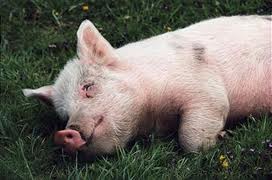 All diseases of pigs mainly occur in the warm season – late spring and summer. Most other pigs exposed to the disease erysipelas, or rubella, which mainly captures the pigs aged 4 to 12 months.
All diseases of pigs mainly occur in the warm season – late spring and summer. Most other pigs exposed to the disease erysipelas, or rubella, which mainly captures the pigs aged 4 to 12 months.
Infection faces has the ability to persist very long time in the stalls, or pastures eaten by pigs rubella patients. She persists in box, which had been fertilized with manure of infected animals, and especially – in places where the corpses of the fallen were buried pigs.
Infection caught in the animal’s body produces its destructive effect immediately, is 3 – b, sometimes seven days before starting to show signs of disease. However, the disease, according to latency appears very rapidly. Swine suddenly become very restless: grunt, angrily rushing to stall, it is no longer there. Then they try to be somewhere in a cool dark place, burrow into the straw, where he lay motionless. They have a vomiting eyelids swell greatly, from my eyes flow with tears. After a while the diarrhea begins, at what discharge are extremely smelly and often with blood, and in the meantime on the skin (mainly – on the head, ears, belly) are red spots that become darker, so that white pigs have the same form if they were doused with Burakov kvas. The disease lasts sometimes 2-3, sometimes 3-4 days in most cases ends in death cases. In some cases, the face is a protracted form of the animals are sluggish, take a little food, lose weight, often lie on the chest, coughing. Recovery occurs rarely, in most cases, patients are gradually depleted, and falling. Sometimes this is added to all parts of the necrosis of the affected redness of the skin: The skin in these areas is no longer inflamed and sometimes falls off the ears, tail, etc.
Second, it is extremely contagious disease of pigs, it’s – cholera pigs. It affects mainly pigs and in most cases ends in death. Infection of cholera, based in large quantities of manure and urine of patients with fever, as erysipelas, – a very long time remained in force in damp places. From the beginning of infection until the first signs of the disease is usually 5 – 7 – 10 days. The first signs of cholera are very similar to the symptoms of erysipelas, lethargy, lack of urge to food, vomiting, constipation in the beginning, and then – diarrhea, which is often bloody. The illness usually lasts a little longer than the mug, and death occurs at 5-7 days. It is often the case that an animal is sick two or three weeks, until it comes complete exhaustion. Often, when cholera is a disease of the stomach and intestines (diarrhea) joins another lung disease that is recognized by frequent, painful cough and the expiration of the nose.
Swine fever in most cases occurs very rapidly. Begins abruptly, after a few hours after infection, plague immediately stuns animal, which appears so weak that it staggers when walking, and then formed on the skin red spots, often from the nose and anus, and bleeding occurs in a day, and sometimes even faster, death occurs. In cases where the disease is prolonged in patients with a cough, discharge from the nose, bloody diarrhea.
From the description of these diseases can be seen that by their appearance is extremely difficult to distinguish from one another not only a simple villager, but sometimes the veterinarian. But doctors can pinpoint the disease, making the study of the blood of sick animals. A precise definition of disease is extremely important, as for the treatment of each disease, there are special tools that can be applied by a doctor.
In view of the fact that the recognition of symptoms of the disease is extremely difficult, it should be, whenever in the economy appears “sea pigs” immediately notify the nearest veterinarian.
Treat the same without a doctor infected with erysipelas, plague, cholera or fever – a hopeless task.
Therefore, all the attention in the fight against “swine plague” should be reminded that in order to prevent occurrence of disease or prevent its dissemination. In the first case, you must not let the pigs suspected pastures, where there have been cases of case, do not let strangers walk in the crib and svinarnyam not put in the same room with the newly acquired domoroslymi pigs. At the first disease should immediately separate the healthy and surpass them in some remote area of the patients, give them a good, hearty food, adding to the drinking of hydrochloric acid (spoon in a bucket), do not let them on pasture. Fallen – deeply buried in such places do not go to healthy pigs. But the most correct way to prevent a swine erysipelas vaccine. Carry it should not when the pigs have already started to hurt, but before that, the best-spring. The desire to produce vaccinated pigs must notify their veterinarian well in advance: in early spring. Against cholera and swine fever vaccinations are usually applied already at the beginning of the disease, since they are and healing. In households where there was one of the specified diseases of pigs, it is necessary to produce disease after cessation of thorough cleaning of all rooms, where the sick pigs. Purification (“disinfectant“) is to clean the manure from the stables, and soot (manure is best to burn), ventilation, and then carefully pouring the floor, walls, as well as all subjects were in a stable solution creolin or carbolic acid (one hundred parts of water, three of drugs), or lime-water (30-35 pounds of lime buckets of water) and hot liquor.
- Reblog
-
Subscribe
Subscribed
Already have a WordPress.com account? Log in now.
You must be logged in to post a comment.